Most Indians don’t know the true history of Hinduism. They think ancient Indian Vedic Brahmanism and present Hinduism are the same. Also, they believe Hinduism is Sanatan, or existing or continuing forever. The reason for this is that the history of Hinduism and India is distorted by Brahminists. Let me explain with some examples.
Note: This is the second post in the blog post series that exposes Sanatana Dharma, the Varna system, or caste system, which discriminates against 90% of Indians and is the root cause of many socio-economic issues in India. I suggest you read the remaining posts mentioned in the first post to have a comprehensive understanding of Sanatana Dharma.
Origin of the words 'Hindu' and 'Hinduism'
“Hindu” is not an Indian word by origin1. Also, the word ‘Hindu’ didn’t exist in ancient Vedic or Brahmanical literature like the Vedas, Puranas, and Upanishads.
In ancient history, the Greeks, then the Persians, used the word Hindu to refer to the land and people beyond the Indus (or Sindhu) River. The word Hindu was first used by Greek authors, beginning with Herodotus in the 6th century. The words Hindu, Hindus, Hindustan, and Hinduism have no connection with ancient India.
Later, between 1400 and 1600 CE, Indian thinkers like Kabir, Eknath, and Guru Nanak spoke about Hindus in a religious sense to represent non-Muslims living in India. During this period, the various groups identified themselves with their philosophical and spiritual practices, such as Vaishnavas, Shaivas, Shakta (worshippers of Mahadevi), Mahayana, Advaita, etc. But no one called themselves Hindus.
Finally, using the word Hinduism to refer to a religion became popular only in the 19th century, first by the British and then by Hindus themselves to identify themselves as different from Muslims and others. In 1816, Rammohan Roy, a Hindu reformer, was maybe the first Hindu to use the word ‘Hindooism’. He referred to ‘Hindooism’ as a social practice associated with caste.
The history of Hinduism is the Brahmanization of various religions and cultures.
Vedic Brahmanism
Vedic Brahmanism was an ancient religion practiced by Indo-Aryans who migrated to the Indian subcontinent in various phases between 2000 and 1000 B.C. The Vedas, Purans, Upanishads, and their other literature are collectively known as Vedic or Brahmanic literature. The Sanatana Dharma and the Varna system, or caste system, were part of Vedic Brahmanism. The caste system is the most discriminative, unjust, and exploitative social system in the world.
Brahmanization of Hinduism:
It is quite common for many religions and cultures to borrow practices from other religions and cultures without committing to any doctrine. Brahmanization is not just borrowing but the complete appropriation of other religions and cultures in a way that benefits Aryans, especially Brahmins. I explained it with examples in the next sections.
Demonization of indigenous Indians in Vedic literature and Hindu festivals:
The migrated Indo-Aryans demonized the settlers of Indus Valley Civilization (IVC) and other ancient ancestral Indians in their Vedic literature and insulted them with derogatory names like Asuras (demons) and Rakshashas (demons). IVC settlers and other ancient ancestral Indians are the ancestors of the non-Aryan Indians, who are today’s BC, SC, ST, and non-Aryan OC caste people. Many Hindu festivals are symbolic celebrations of the victory of Indo-Aryans over indigenous kings and heroes. But most Hindus, who are indigenous Indians, are not aware of this. They worship the gods or kings who helped Vedic Aryans kill or subordinate indigenous kings or heroes. I will write a detailed post on the origin of Brahmanized Hindu festivals.
Appropriation of other gods, religions and cultures by Brahmanism:
Brahmanists appropriated other religions and cultures. They transformed the ancient tribal and local deities into Brahmanical Vedic deities with fictional stories and created new fictional deities to strengthen the Varna System. I gave a few examples below.
Sacred fig tree
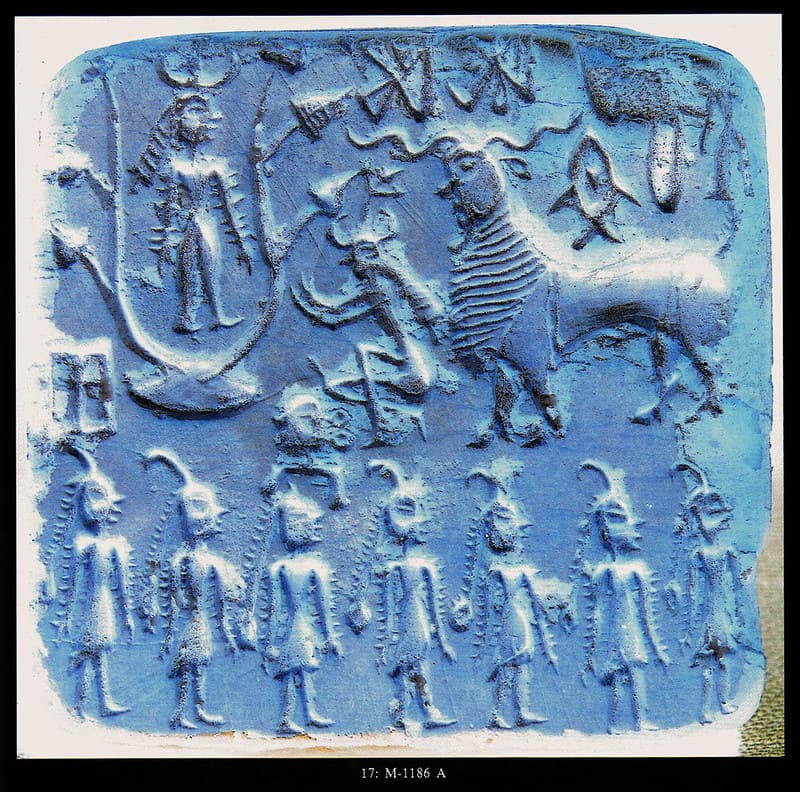
Image: Ritual ceremony by Peter licensed under CC BY-NC-SA 2.0
A Mohenjo-daro seal depicting a deity (top left) with horned headdress and bangles on both arms, standing in a pipal (sacred fig) tree and looking down on a kneeling worshiper.
The Harappan or Indus Valley Civilization (IVC) people worshiped trees, including the peepal or sacred fig tree. Their civilization lasted from 3600 B.C. to 1300 B.C. The Vedic Brahmins appropriated the worship of the fig tree. It was mentioned in Vedic literature like the Rig Veda, Katha Upanishad, and Bhagavad Gita, which were composed after 1500 B.C.
Pashupati as Shiva
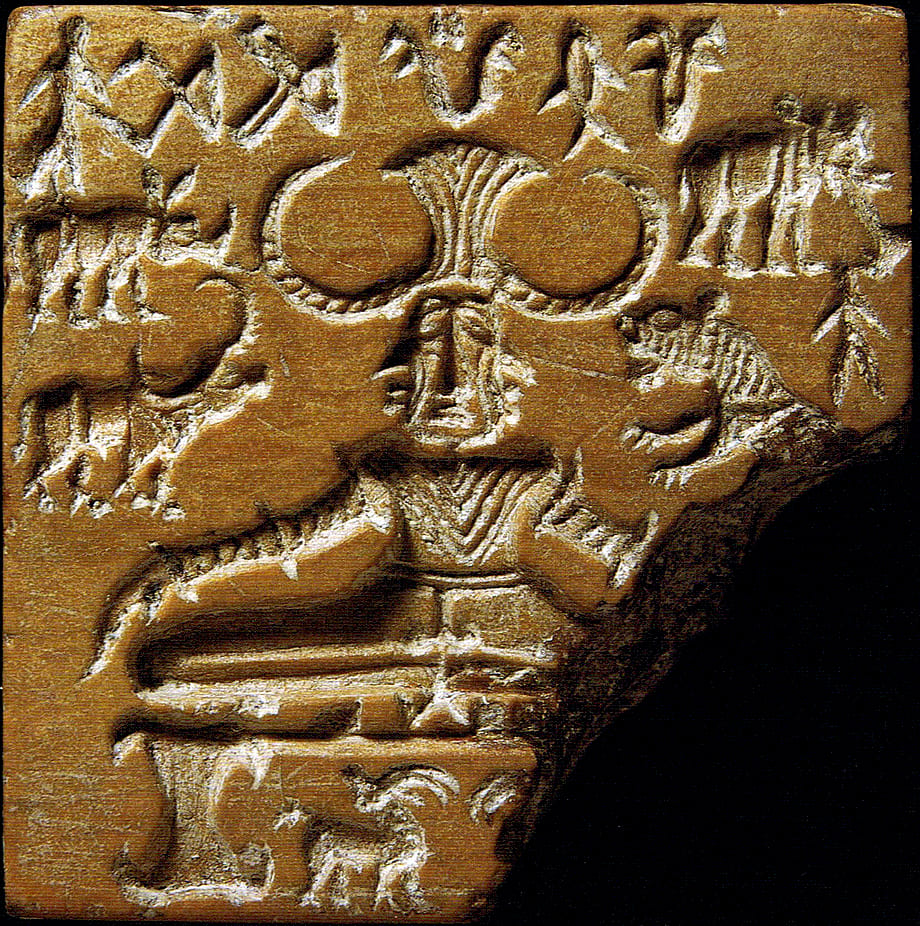
Pashupati seal by Columbia University.
Image: The Pashupati seal (2350–2000 BCE) uncovered in Mohenjo-daro, a major urban site of the Indus Valley Civilisation (IVC).
“Pashupati seal” was found in Mohenjo-Daro, an Indus Valley city, in 1928 excavations. The Brahminists claim the seal represents proto-Shiva in a sitting yoga position. Many scholars disagree with this and suggest Pashupati might be a female deity of the Indus Valley. One simple logic that goes against the claim of the Brahminists is that Shiva as a Yogi was mentioned in Vedic literature between the 4th and 5th centuries BCE. How can Pashupati become Shiva who existed 2,000 years before this? It is not true that Pashupati is Shiva except that later in history they mention this in their scriptures for their own benefit.2 3
Buddha as Vishnu
The Vedic Brahmins used to eat beef and sacrifice cows for Vedic rituals, but they stopped eating beef and made beef eating a sin to counter Buddhism. Because at that time animal husbandry and farming were the main livelihoods of most people, Buddhism was against animal sacrifice, and for other reasons, Buddhism became more popular than Brahmanism and became a threat to Vedic Brahmanism.
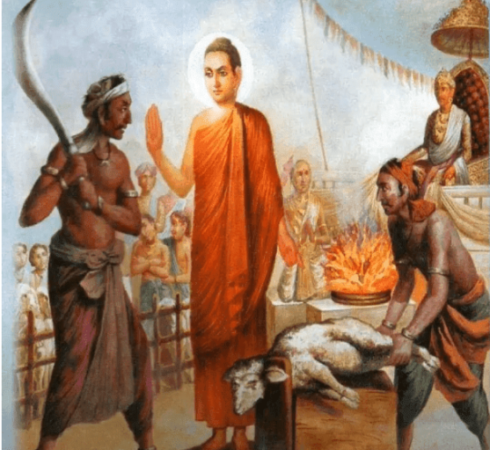
Buddha stopping animal sacrifice. Source: Abhinav Kumar
Vedic Brahmins fought against Buddhism for over 400 years and tried to destroy it. As they couldn’t succeed completely, they tried to consume Buddhism by calling it refined Brahminism. Now the Brahmanists are calling Buddha the 9th avatar of Vishnu.
Shabari as Kali
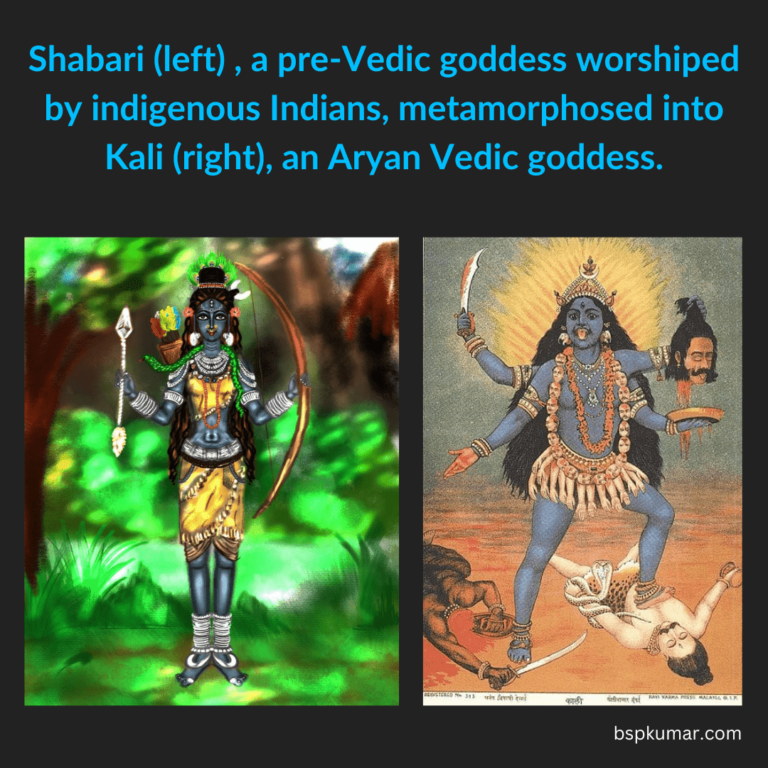
Vedic goddess Kali dancing on Shiva painted by Raja Ravi Varma and published on World History Encyclopedia
Indian aboriginal tribes worshiped female deities. For example, East Indian ancient forest dwellers and hunters Shabars worshipped Shabari. Now people from different castes and religions worship her. This practice dates back to the pre-Vedic era.
These goddesses have no connection with Vedic Brahmanism. However, Brahminists metamorphosed such local goddesses into Kali, a Vedic goddess.4
Jagannath as Vishnu
Scholars suggest Lord Jagannath was a tribal deity worshiped by Sora (Savara) tribes who live in southern Odisha and north-coastal Andhra Pradesh. Brahiminists claim Jagannatha was a Puranic god and the manifestation or avatar of Vishnu, Krishna, and Shiva. But there is no historical evidence of worship of Jagannath at Puri prior to the 10th century A.D.5
Murugan as Kartikeya
Murugan was appropriated as Kartikeya, a son of Vedic god Shiva. “Murugan was originally a hero warrior who was worshipped by the tribals of the Kurunji land, which later emerged into a separate cult. The lord was characterized as an eternally youthful, handsome and mighty warrior. After the Bhakti movement that swept the south, bigger Vedic gods like Shiva and Vishnu became popular and Muruga cult became restricted to pockets of Tamil Nadu.” says Retired Professor of Art History, Dr. R. Venkatraman.6
Bathukamma
Peasant communities in the Indian state of Telangana worship nature and the goddess Bathukamma. Brahminists distorted the history of Bathukamma and turned her into the Vedic goddesses Lakshmi and Parvati. Now Brahmins, who don’t have any relation to this festival, are deciding when the peasant communities should celebrate Bathukamma. They denied the celebration of Bathukamma to Dalits in some villages of Telangana state.
Sammakka
They didn’t even leave tribal legends like Sammakka. Sammaka was a tribal legend from the Koya Tribe who lived in the Indian state of Telangana. She fought against Prataparudra of the Kakatiya dynasty, which imposed taxes on the Koya tribe. But Brahmins claim Sammakka as a manifestation of Adi Parashakti.
Kali, Lakshmi, and Parvati are different forms of the Vedic goddess Adi Parashakti. Like the way they tried to destroy Buddhism, Brahminists tried to destroy local religious practices. When their efforts were not completely successful, they created stories around the local goddesses, included the stories in their religious scriptures, and absorbed the local goddesses into Brahmanized Hinduism.
While Brahmnists metamorphosed many local goddesses into Kali. According to many scholars, Kali is also a non-Vedic and pre-Aryan local goddess7, who was absorbed into Vedic Brahmanism.
The history of these goddesses mentioned on Wikipedia and many Brahmanical websites is distorted.
Aryanization of the Indus Valley Civilization:
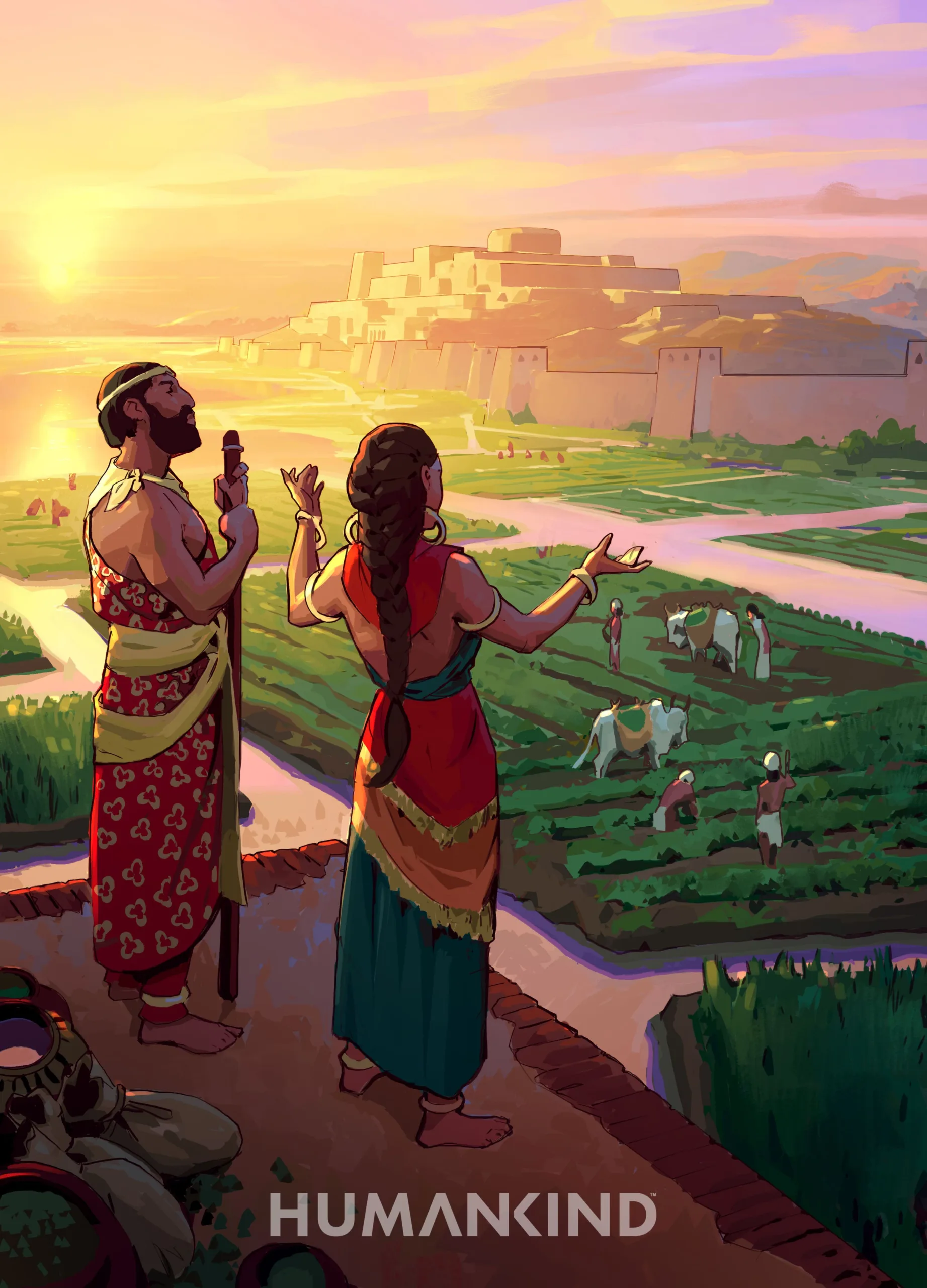
Image: An artist’s impression of Indus Valley Civilization by Amplitude Studios published on worldhistory.org
Until 1921, Brahminists had been fooling the world into believing that ancient Indian history was all about the Vedic period and literature and that Aryans were the indigenous Indians.
The discovery of the Indus Valley Civilization (IVC) in excavations in 1921 was a big blow to Brahminical propaganda. Because IVC existed from 3,600 B.C. to 1,300 B.C. IVC was a well-urbanized civilization, with cities well planned, trade links established, and farming developed. It outshined the so-called superior Vedic culture, as boasted by Brahmnists. The Indo-Aryans were nomadic pastoralists when they migrated to the Indian subcontinent and encountered IVC, which was in the decline stage.
However, Brahminists always denied both Aryan Migration Theory (AMT) and Aryan Invasion Theory (AIT). Most scholars now don’t believe in AIT, but AMT was proved in many archaeological, genetic, linguistic, and historical studies 8 9
Also, the studies proved IVC settlers are different from Indo-Aryans. Most accepted studies 10 11 suggest IVC settlers spoke Proto-Dravidian languages. Tamil was one of the Dravidian languages that originated from Proto-Dravidian languages. They might have spoken other languages like Proto-Munda, but no studies proved the existence of Indo-Aryan languages like Sanskrit in the IVC.
However, since the discovery of IVC, the Brahmnists have been spreading propaganda that Aryans were indigenous to India with the help of pro-Hindutva media publishing houses like Voice of India. They have been trying to Aryanize IVC. It involves finding suitable data to prove the links between Vedas and IVC and proving either IVC as Vedic civilization or Vedas existed before IVC. They invented an unproven ‘Out of India’ theory, which says Indo-Aryans are aboriginals of India and the Indo-Aryans migrated out of India.
The data they used to prove their propaganda was either fake, selective, or unscientific. Their claims were always debunked multiple times by scholars from various fields.
After the BJP came to power in 1998, they initiated many projects to find suitable data that would support their Brahminical Hindutva propaganda. Many pro-Hindutva Brahmanists work in various organizations like the Archaeological Survey of India (ASI), IITs, and other government organizations and universities are part of these projects. I mentioned a few such programs below.
The fake 'horse seal' of the Indus Valley Civilization
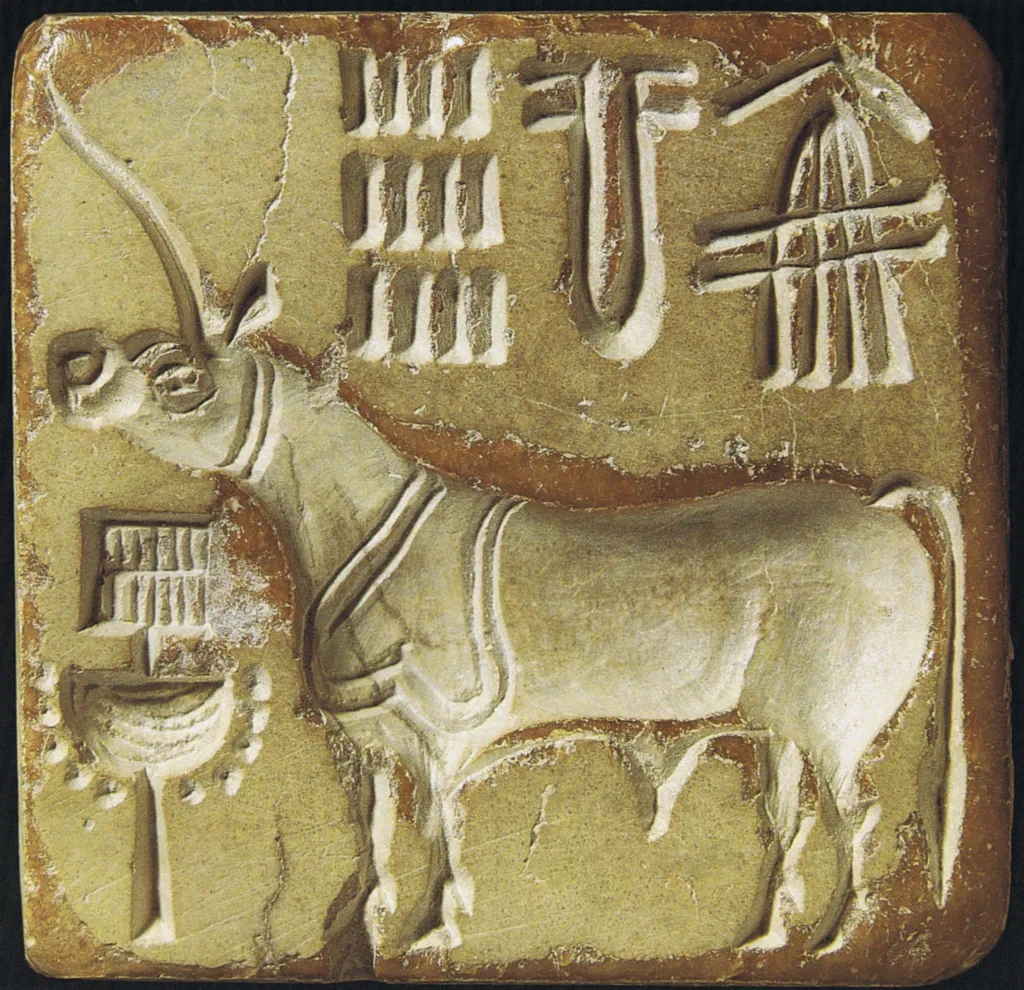
Image: one-horned bull on an Indus Valley Civilization seal by Peter licensed under CC BY-NC-SA 2.0
The fake ‘horse seal’ was a computer-generated distorted image of the original image of a bull with archeological number Mackay 453. It was a picture from Vol. II of Ernest Mackay’s work, published in 1942. He was a British archeologist who did major excavations and studied at Mohenjo-daro and other sites of the IVC.
Rajaram, a U.S. engineering professor in the 1980s, created the distorted image. He became a Hindutva propagandist and “revisionist” historian in the 1990s. The fake ‘horse seal’ was mentioned in the 2000 book The Deciphered Indus Script, written by Rajaram and palaeographer Dr. Natwar Jha.
IVC settlers domesticated bulls, but horses didn’t exist in IVC. Indo-Aryans brought horses to the Indian subcontinent. Horses were widely mentioned in the Rig Veda. What Brahminists want to prove by showing the existence (fake) of horses in IVC is that the Vedic culture was native to India and the fake Aryan ‘Out of India’ migration theory.
The fake ‘horse seal’ propaganda was debunked by scholars 12 13 14
Indus-Sarasvati Civilization propaganda:
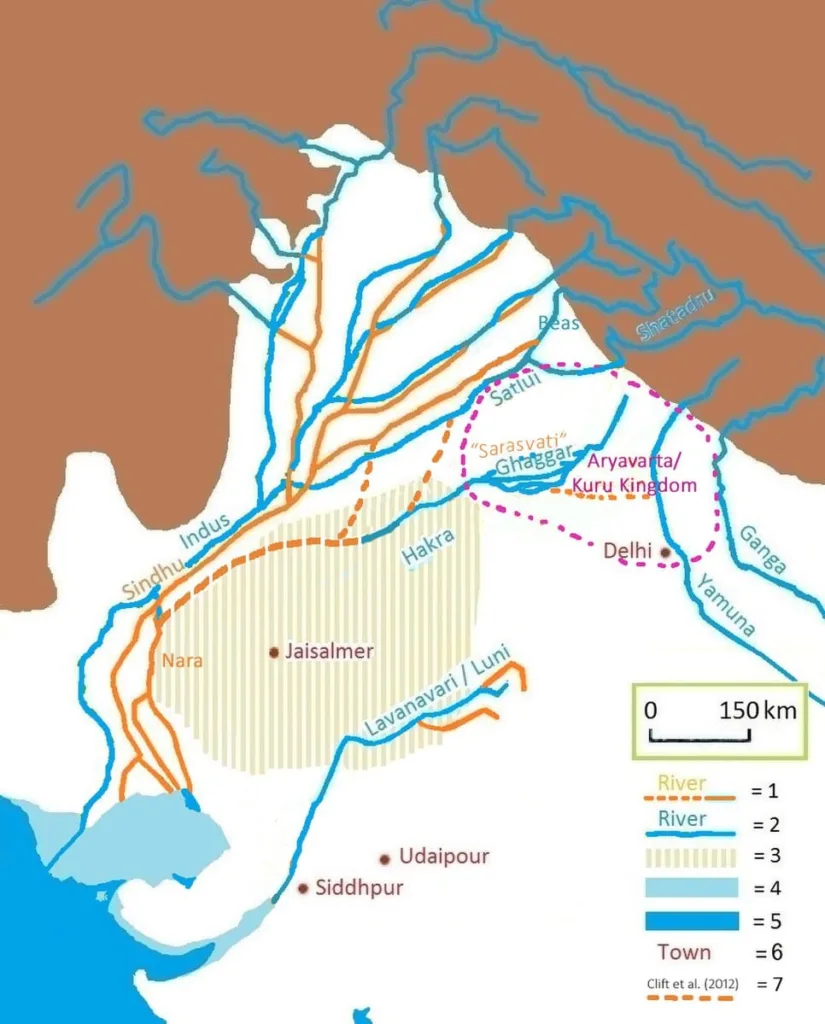
The BJP government started the Saraswati Heritage Project in 2003 to start excavations at 15 sites in Haryana, Rajasthan, and Gujarat. Brahmanists claim the mythological and mighty Sarasvati River flowed along these sites; according to Vedic literature, the present-day Ghaggar-Hakra River was the Sarasvati River.
Mani, who has directed more than 14 excavation projects and has also written extensively on the ‘Indus-Saraswati’ civilization, mentioned: “early antiquity of new material from sites such as Bhirrana in Haryana has put Indian civilization in the 8th millennium BC.” He suggested Haryana and Rajasthan as the epicenters of pre-Harappan cultures.
With this, they want to prove the Vedic Aryans as the indigenous Indians, and the purported Vedic-Harappan civilization lies within today’s India. In fact, most of the IVC sites exist in Pakistan today. But that will not help the RSS and BJP build their fake nationalist agenda, or Hindutva.
Many scholars rejected Mani’s hypothesis as historically inaccurate and unscientific.
One archaeologist from ASI anonymously told India Today:
The fact is that there is no clear archaeological evidence to suggest where the Saraswati flowed or if it flowed at all.
Shereen Ratnagar, an Indian archaeologist, mentioned in her 2006 book Understanding Harappa: Civilization in the Greater Indus Valley:
If in an ancient mound we find only one pot and two bead necklaces similar to those of Harappa and Mohenjo-daro, with the bulk of pottery, tools, and ornaments of a different type altogether, we cannot call that site Harappan. It is instead a site with Harappan contacts.
Shereen Ratnagar, an Indian archaeologist in her book Understanding Harappa: Civilization in the Greater Indus Valley' Tweet
Indian historian Romila Thapar said:
Furthermore, the early references to Sarasvati could be to the Haraxvati Plain in Afghanistan. The identification is also problematic, as the Sarasvati is said to cut its way through high mountains, and this is not the landscape of the Ghaggar.
Romila Thapar in her book 'The Penguin History of Early India - From the origins to AD 1300' Tweet
In his book, The River Sarasvati: Reconciling the Sacred Texts, Professor Rajesh Kochhar said15
The Ghaggar was already defunct when the Indo-Aryans encountered it, and that many rivers to the east of Sutlej were given Rig Vedic names for the sake of nostalgia.
Professor Rajesh Kochhar in his book, 'The River Sarasvati: Reconciling the Sacred Texts' Tweet
Therefore, there is no evidence that the Saraswati river mentioned in the Vedas is the same as the Ghaggar Hakra river that now flows in western India. Also, there is no evidence that the Indus civilization developed near the Ghaggar Hakra river, not near the Indus river in Pakistan, and that the Indus civilization and the Vedic civilization are the same.
False reporting of the DNA studies
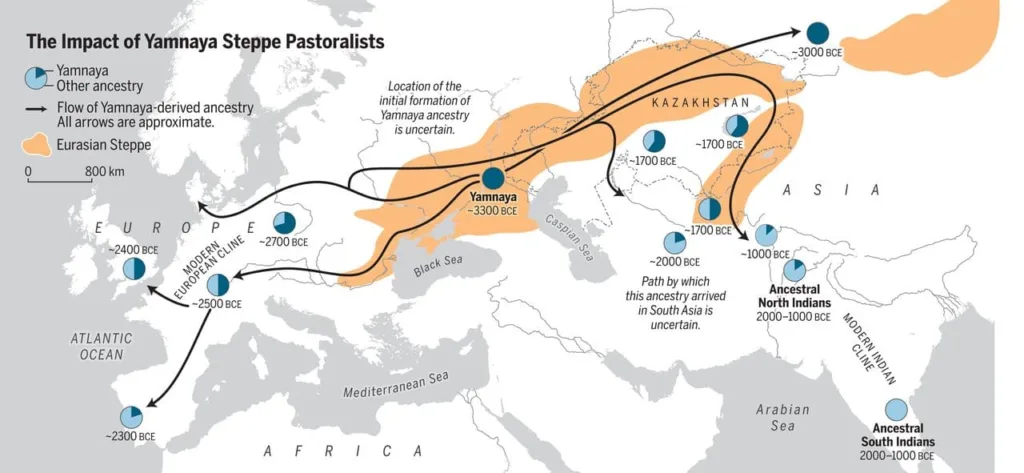
Image: The Bronze Age spread of Yamnaya Steppe pastoralist ancestry into two subcontinents—Europe and South Asia. Source: Science research article “Ancient human movements through Asia.”
Cell Press published the results16 of a DNA study named “An Ancient Harappan Genome Lacks Ancestry from Steppe Pastoralists or Iranian Farmers” in September 2019. The study is based on the 4-5 DNA samples collected from Rakhigarhi, a key Harappan site in Haryana. archaeologist Prof. Vasant S. Shinde and Niraj Rai, head of the Ancient DNA Lab at Lucknow, co-authored the paper along with others.
One day later, Science published the results17 of another DNA study named “The Formation of Human Populations in South and Central Asia.” The study is based on DNA samples collected from 523 individuals who lived over the past 8,000 years in Central and northernmost South Asia. Prof. Shinde was a co-author of this study as well.
The results announced by Shinde and Rai in a press conference were contradictory to the results of both studies. Other co-authors disagreed with the claims of Shinde and Rai and said the claims were politically motivated.
What the reports said:
Cell report: The people of the Indus Valley had no Steppe (Indo-Aryan) DNA. They mainly had a mixture of DNA from Iranian farmers as well as some DNA from ancient Ancestral South Indians. Which means the Steppe or Indo-Aryan DNA that exists in Indians today mixed with the DNA of Indus Valley people later. In other words, it supports the Indo-Aryan migration theory.
Science report: Some of the indigenous IVC people who mixed with the migrated Steppe people (Indo-Aryans) formed the bulk of the Ancestral North Indian (ANI or West Eurasian*) population. The IVC people, who were pushed south when Indo-Aryans entered the Indian subcontinent and mixed with Ancient Ancestral South Indians (AASI), formed the bulk of the Ancestral South Indian (ASI) population. However, this model can’t explain the ancestry of Bengalis and other East Indian people in Southeast Asia.
Also, the report suggested ASI most likely spoke an early Dravidian language. Findings from historical and linguistic research and the geographical spread of Dravidian languages from South India to today’s IVC locations in southwestern Pakistan also suggest the same.
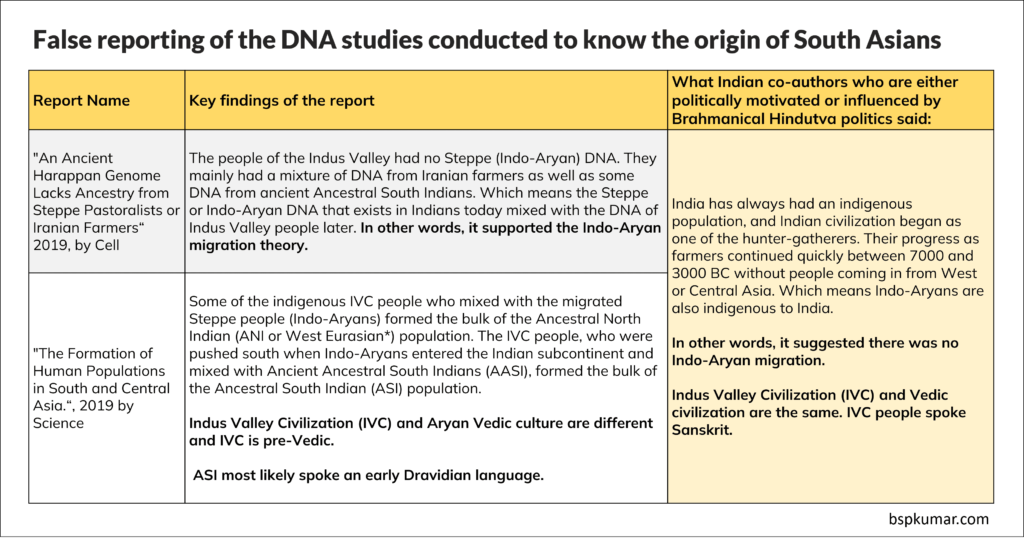
But what the Indian authors claimed:
India has always had an indigenous population, and Indian civilization began as one of the hunter-gatherers. Their progress as farmers continued quickly between 7000 and 3000 BC without people coming in from West or Central Asia. Which means Indo-Aryans are also indigenous to India. In other words, it says there was no Indo-Aryan migration. Indus Valley Civilization (IVC) and Vedic civilization are the same. IVC people spoke Sanskrit.
But both of these DNA studies and other archeological, linguistic, and historical studies strongly suggest Indo-Aryan migrations happened; IVC is pre-Vedic, and IVC settlers most likely spoke early Dravidian languages.
However, the Hindutva Brahminists never agree with the facts. Because the facts don’t fit the Hindutva ideology. The Hindutva ideology defines the true Indian as being a native Indian who follows the native religion. Brahmanists, who are mostly Indo-Aryans, and their religion, Vedic Brahmanism, aren’t native to India by their own definition. That’s why they try to find suitable data that supports their ideology.
Keezhadi, a 6th-century B.C. city—a link between IVC and Tamilnadu history? And the BJP's politics:
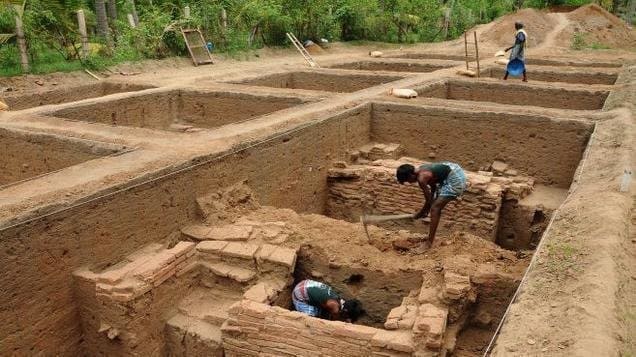
The excavations at Keezhadi, Tamil Nadu, shed a new light on the history of the Tamil people. The key findings include graffiti marks similar to those that are believed to have evolved from the Indus Valley script. The findings strengthen the suggestions made by various studies that IVC settlers spoke proto-Dravidian languages.
The Keezhadi civilization was a highly advanced urban society, and the carbon dating dates it to the 6th century B.C.
Another interesting finding was that no religious symbols or anything relating to any deity were found. It was a secular society and had no interaction with Vedic literature.
The graffiti marks and the secular nature of this society definitely don’t fit with the religious Hindutva ideology, which is based on Vedic literature composed in Sanskrit.
The Archeological Survey of India (ASI), which works under the central government, started the first phase of excavations in 2015. However, the excavations from the third phase got delayed.
The Tamil Nadu Archaeology Department took over the excavations in 2018, and the 8th phase of excavations began in 2022.
According to Tamil academicians and politicians, the BJP made deliberate attempts to stop the excavations as the findings were not in favor of Hindutva ideology.
Historical negationism and glorifying pro-Hindutva authors:
Historical negationism, also called historical denialism, is the falsification or distortion of the historical record.
The BJP government is known for appointing pro-Hindutva authors to government organizations like the Archeological Survey of India and the Indian Council of Historical Research and glorifying them. The RSS and BJP use the unscientific and biased work of these authors to distort history in favor of Brahmanism and Hindutva.
One example is the case of Michel Danino. He is an author, a guest professor at IIT Gandhinagar, and a member of the Indian Council of Historical Research.
He is known for pro-Hindutva historical distortion and falsification of the well-researched DNA studies of scholars who study human migrations. He denies the studies that proved Indo-Aryan migrations to the Indian subcontinent and suggests the ‘Out of India’ theory, or migrations of Indo-Aryans out of India, without citing any well-researched study.
In his book, The Lost River: On the Trail of the Sarasvati, he identified the mythological Sarasvati River with today’s Ghaggar-Hakra River. As I discussed earlier in this post, there are no scientific studies to prove this.
Various scholars denied his claims and criticized him for promoting sectarian and pro-Hindutva views. Here is what scholars have said about him:
Sudeshna Guha, a professor at Shiv Nadar University, said18
Curiously, individuals who do not exactly qualify as scholars of the field and those sharing sectarian views, such as David Frawley, Koenraad Elst, Navaratna S. Rajaram, Bhagwan Singh, and Michel Danino, are being allowed to present their non-scholarly opinions on Indian history through the once prestigious journals devoted to Indian archaeology, Man and Environment, and Puratattva.
Sudeshna Guha, a professor at Shiv Nadar University Tweet
Ashish Avikunthak, a professor at the University of Rhode Island, said19
This uncertainty has fostered Hindutva scholarship that challenges the idea of Aryan migration into India and argues that the Aryans are indigenous to India (Danino and Nahar 1996; Deo and Kamath 1993; Elst 1999; Frawley 1994; Rajaram 1993; Rajaram and Frawley 1995; Talageri 1993).
Ashish Avikunthak, a professor at the University of Rhode Island Tweet
Hinduism was never Sanatan. Why do Brahmanists distort the history of Hinduism and India?
As I explained in my previous sections, Brahmanists have been appropriating other religions, cultures, and gods and distorting the history of their own and indigenous Indians. They kept changing the gods they worshiped. First, they worshiped Vedic goddesses like Prithvi and Aditi. Later, there were Vedic gods like Indra, Surya, and Agni. Next, Vaishnavite gods like Rama and Krishna, and Shaivite gods like Shiva, and now Swami Narayan and Sai Baba. They even worshiped Muslim religious gurus.
In his book Riddles in Hinduism, Babasaheb Ambedkar said20
I want to make the mass of people realize that Hindu religion is not Sanatan. The second purpose of this book is to draw attention of the Hindu masses to the devices of the Brahmins and to make them think for themselves how they have been deceived and misguided by the Brahmins.
Babasaheb Ambedkar, in his book 'Riddles in Hinduism' Tweet
Also, he said, “One may well ask them—where is Indra, where is Varuna, where is Brahma, where is Mitra—the gods mentioned in the Vedas? They have all disappeared. And why? Because the worship of Indra, Varuna, and Brahma ceased to be profitable, not only did the Brahmins abandon their Vedic gods, but there are cases where they have become the worshippers of Muslim Pirs.” He was referring to a Darga of Pir called Bawa Malangsha near Kalyan, Mumbai. They did so for the sake of money.
For Brahmins, religion is commerce. Religious rituals and ceremonies are a source of income for Brahmins. There are around 40 samskaras, or religious ceremonies, in Hinduism. Some of the ceremonies that are still in practice include Simanta (baby shower), Namakaran (naming ceremony), Annaprashana (ceremony to feed the first non-milk food to babies), Vivaha (marriage), and Pinda Dana (funeral rites). Religious rituals were the main source of income for Brahmins during the Vedic period.
Also, as I explained in my first post in this series about Sanatana Dharma, Brahminists appropriated other religions and cultures to forcefully draw them into the Varna System and maintain their supremacy over indigenous Indians. The Varna System is a hierarchical social system that defines the social status of a person, who should do which rituals, and who can have access to resources like learning and material wealth.
From Vedic Brahmanism to Brahmanized Hinduism to Hindutva ideology, Brahmanism, Sanatana Dharma, Varna System, or caste system masked themselves in religion to maintain the supremacy of Brahminists.
So, the Brahmnists are distorting the history of Hinduism and India to suit their ideologies, which are evolving to maintain their supremacy.
The outward appearance of Hindutva looks like Hindu nationalism, but it is Brahmanism in disguise. Kindly read about the true nature of Hindutva and RSS in my third post in this blog series.
I think no one in the world is so obsessed with migrations that happened in their countries and distortions of history except Brahminists and Hindutva ideologists, who want to maintain the supremacy of Brahmins/Brahminists.
Because the proven Aryan Migration Theory (AMT) proves how Brahminists have been fooling Indians into thinking that Indo-Aryans are native to India; Indian ancient history
Our focus should not be on Indo-Aryan migrations, but understanding how Indo-Aryan Brahminists invented Sanatana Dharma (the Varna System, or caste system) in the name of god to maintain supremacy over the then indigenous Indians; how Brahminists covered Sanatana Dharma under religion and fake nationalism and facilitated its survival for more than 3000 years; that Sanatana Dharma is the root cause of many socio-economic issues in India; and how to fight against it. Otherwise the brahminists create new ideologies or twist the existing ideologies in their favor.
Footnotes
- Comparative Studies in Society and History , Volume 65 , Issue 2 , April 2023 , pp. 246 - 271
DOI: https://doi.org/10.1017/S0010417522000524. - 'Shiva of the Indus valley' by Meera Nanda, a historian of science: https://thewire.in/the-sciences/the-age-of-the-unicorn-brought-to-you-by-iit-kharagpur
- 'Pashupati and the Harappan Seal' by Devdutt Pattanaik: https://devdutt.com/pashupati-and-the-harappan-seal/
- Revisiting Kali (Shabari): An Amalgam of Aboriginal Deities and a Symbol of Rebellion: https://thewire.in/religion/kali-aboriginal-roots-and-symbol-of-rebellion
- Lord Jagannath - The Tribal Deity by Dina Krishna Joshi: https://magazines.odisha.gov.in/orissareview/june_july-2007/engpdf/Pages80-84.pdf
- Tracing the roots of the Tamil God Murugan (Kartikeya): https://www.thehindu.com/features/metroplus/society/tracing-the-roots-of-the-tamil-god/article6808508.ece
- Kali is a pre-Vedic and non-Aryan goddess: Page no. 94, The Book of Kali by Seema Mohanty, https://books.google.co.in/books?redir_esc=y&id=3KyfCUvoAtoC&q=pre+aryan#v=twopage&q=pre%20aryan&f=false.
- An Ancient Harappan Genome Lacks Ancestry from Steppe Pastoralists or Iranian Farmers: https://www.cell.com/cell/pdf/S0092-86741930967-5.pdf.
- The formation of human populations in South and Central Asia
https://www.science.org/doi/10.1126/science.aat7487. - The formation of human populations in South and Central Asia
https://www.science.org/doi/10.1126/science.aat7487. - Ancestral Dravidian languages in Indus Civilization: ultraconserved Dravidian tooth-word reveals deep linguistic ancestry and supports genetics authored by Bahata Ansumali Mukhopadhyay: https://www.nature.com/articles/s41599-021-00868-w.
- The Bogus Indus Valley ‘Horse Seal’ by Steve Farmer: https://safarmer.com/horseseal-update.
- HORSEPLAY IN HARAPPA: MICHAEL WITZEL, a Harvard University Indologist, and STEVE FARMER, a comparative historian, report on media hype, faked data, and Hindutva propaganda in recent claims that the Indus Valley script has been decoded. https://frontline.thehindu.com/cover-story/article30255049.ece.
- The Indus Script by Iravatham Mahadevan: The evidence strongly suggests that the Indus culture was non-Aryan. https://www.harappa.com/script/maha3.html.
- The River Sarasvati: Reconciling the Sacred Texts, Professor Rajesh Kochhar: https://www.google.co.in/books/edition/Archaeology_and_Language_III/h8jfBQAAQBAJ?hl=en&gbpv=1&pg=PA257&printsec=frontcover .
- An Ancient Harappan Genome Lacks Ancestry from Steppe Pastoralists or Iranian Farmers: https://www.cell.com/cell/pdf/S0092-86741930967-5.pdf.
- The formation of human populations in South and Central Asia: https://www.science.org/doi/10.1126/science.aat7487.
- Page no: 421, Negotiating Evidence: History, Archaeology and the Indus Civilisation by Sudeshna Guha, Professor, Department of History and Archaeology, Shiv Nadar University, Delhi: https://www.jstor.org/stable/3876625
- Page no: 58, Conjuring a river, imagining civilisation: Saraswati, archaeology and science in India by Ashish Avikunthak, University of Rhode Island: https://www.academia.edu/21392282/Conjuring_a_river_imagining_civilisation_Saraswati_archaeology_and_science_in_India
- Page 25, Riddles in Hinduism by Babasaheb Ambedkar: https://www.mea.gov.in/Images/attach/amb/Volume_04.pdf




